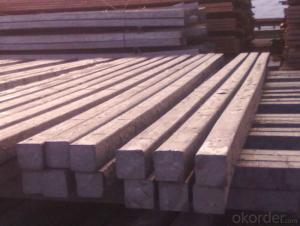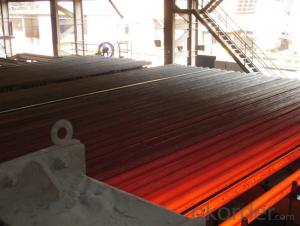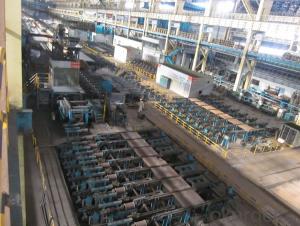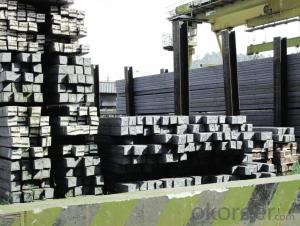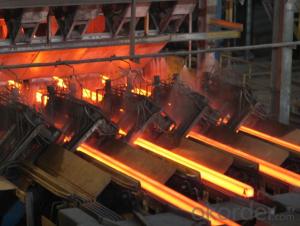Hot Rolled Steel Billet 3SP Standard 100mm
- Loading Port:
- Shanghai
- Payment Terms:
- TT OR LC
- Min Order Qty:
- 100 m.t.
- Supply Capability:
- 10000 m.t./month
OKorder Service Pledge
OKorder Financial Service
You Might Also Like
Structure of Hot Rolled Steel Billet 3SP Standard 100mm

Description of Hot Rolled Steel Billet 3SP Standard 100mm
Prepainted Rolled steel Coil is a kind of coated steel coil/sheet. With the cold rolled steel of different strength and thickness as substrate, it is produced through applying Al-Zn coat on both faces by hot dip process. In its coating, Al accounts for about 55%, Si 1.6%, while the remaining is Zn. Aluminum zinc coils enjoys both the physical protective feature and durability of Al and the electrochemical protective property of Zn. And its surface has bright silver color and regular embossed-like figure, which are highly decorative. RAL Scale Z35 Prepainted Rolled Steel Coil for Construction Roofing

Main Feature of Hot Rolled Steel Billet 3SP Standard 100mm
1.Corrosion resistance: It mainly depends on the zinc protection. When the zinc being worn,
2. Heat resistance: steel sheet has excellent heat resistance, can withstand high temperatures over 300 centigrade, and is similar with aluminized steel high temperature oxidation resistance. It often used in chimney pipes, ovens, fluorescent lighting device and the device cover.
3. Heat reflective: Galvanized steel plate heat-reflective high rate is twice as galvanized steel, often used to make insulation materials. RAL Scale Z35 Prepainted Rolled Steel Coil for Construction Roofing
Applications of Hot Rolled Steel Billet 3SP Standard 100mm
1. Construction and building: roofing; ventilating duct; handrail; partition panel;etc.
2. Electric appliance: refrigerator; washing machine; refrigerator; DVD;etc.
3.Transportation: oil tank; gas tank;road sign; etc.
4.Agriculture constructions :barn; etc.RAL Scale Z35 Prepainted Rolled Steel Coil for Construction Roofing
5.Others:vending machine; game machine; auto parts spare parts etc.
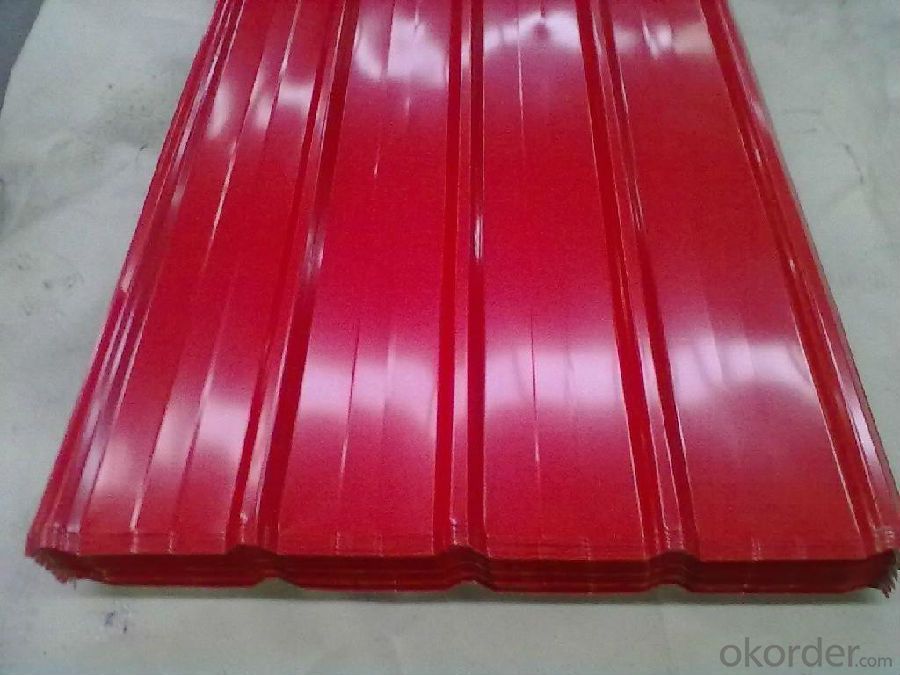
Specifications of Hot Rolled Steel Billet 3SP Standard 100mm
Product | Hot Rolled Steel Billet 3SP Standard 100mm |
Material Grade | SGCC / SGCH / DX51D+AZ, etc |
Thickness | 0.5-3.0mm |
Width | 700-1500mm |
Tolerance | Thickness: +/-0.02mm , Width:+/-2mm |
Zinc-coating | AZ30-150g/m2 |
Technique | Raw material: Hot rolled steel coil --> Cold rolled_>hot dipped galvalume |
Surface | Dried, Chromated, Unoiled,RAL Scale Z35 Prepainted Rolled Steel Coil for Construction Roofing |
Spangle | Regular spangle , small spangle, zero spangle |
ID | 508MM 610MM |
Coil weight | 25MT max |
Export package | Cardboard inner sleeves, Waterproof paper, galvanized steel covered and steel strip packed |
FAQ of Hot Rolled Steel Billet 3SP Standard 100mm
We have organized several common questions for our clients,may help you sincerely:
1. What is the minimum order quantity ?
Our MOQ is 100 mt for each size each specification. Usually we can offer discount if can buy large QTY once. RAL Scale Z35 Prepainted Rolled Steel Coil for Construction Roofing
2. How long can we receive the product after ordering?
Our general delivery time is 30 days after confirmation, but so some special orders, we have offer special delivery time
3. How to guarantee the quality of the products?
We have established the international advanced quality management system ,every link from raw material to final product we have strict quality test;We resolutely put an end to unqualified products flowing into the market. At the same time, we will provide necessary follow-up service assurance.
4. What is the payment?
We accept T/T, L/C
- Q:What are the main uses of steel billets?
- Steel billets are primarily used as raw material in the manufacturing of various steel products, including bars, rods, wire, tubes, and structural components. They are also commonly utilized in the production of seamless pipes, automotive parts, machinery, and construction materials.
- Q:What are the different types of cutting machines used for steel billets?
- There are several different types of cutting machines that are commonly used for cutting steel billets. These machines are designed to provide efficient and precise cuts, ensuring the desired dimensions and quality of the steel billets. 1. Bandsaw: Bandsaw machines are widely used for cutting steel billets. They feature a continuous loop of toothed metal blade that is guided around two or more wheels. The billet is fed into the machine and the blade cuts through the material with high precision. 2. Circular Saw: Circular saw machines use a circular metal blade with teeth to cut through the steel billets. They are commonly used for cutting large billets into smaller pieces. These machines can be operated manually or automatically, depending on the specific application. 3. Waterjet Cutting Machine: Waterjet cutting machines use a high-pressure stream of water mixed with abrasive materials to cut through steel billets. This method is known for its accuracy and versatility, as it can cut through various thicknesses and shapes with ease. 4. Plasma Cutting Machine: Plasma cutting machines utilize a plasma torch to cut through steel billets. The torch generates an electric arc, which is directed through a small nozzle that releases ionized gas. The heat from the arc melts the metal, while the gas blows away the molten material, resulting in a clean and precise cut. 5. Laser Cutting Machine: Laser cutting machines use a high-powered laser beam to cut through steel billets. The laser beam is focused on the material, melting or vaporizing it to create the desired cut. This method is known for its high precision and speed. 6. Shearing Machine: Shearing machines are commonly used for cutting steel billets into specific lengths or shapes. These machines use a blade or a pair of blades to apply a shearing force and cut through the material. They are often used in high-volume production settings. Each of these cutting machines has its own advantages and limitations, and the choice of machine depends on various factors such as the desired cut quality, speed, and the specific requirements of the steel billet cutting process.
- Q:How does billet caster pull out billet cracking?
- There are many kinds of cracks. Which one are you talking about? It is related to the water radian of the crystallizer.
- Q:Can steel billets be used in the production of mining equipment?
- Steel billets, being semi-finished products, find extensive use in the manufacturing industry for the production of mining equipment. The robustness and durability of steel make it an ideal material for mining equipment, which often operates in tough and demanding conditions. By processing and shaping steel billets, essential components like gears, shafts, frames, and buckets can be created, all of which are vital for mining equipment. Moreover, steel billets can be easily welded, machined, and heat-treated to meet the specific requirements and standards of mining equipment. Therefore, steel billets play a critical role in ensuring the strength and dependability necessary for safe and efficient mining operations.
- Q:Charcoal is how to
- The trees cut into sections, lit in a kiln, burning to a certain extent, closed air into the kiln, waste heat to heat water and carbonization of wood, wood tar is leavened, carbonization of wood charcoal as. This is similar to charcoal used in home fires.
- Q:What are the different grades of steel used for producing billets?
- The different grades of steel used for producing billets vary depending on the specific requirements and applications. Some common grades include mild steel, low carbon steel, medium carbon steel, high carbon steel, alloy steel, and stainless steel. Each grade offers different mechanical properties, such as strength, durability, and corrosion resistance, to meet the desired characteristics for the final product.
- Q:What is the role of steel billets in the construction of sports facilities?
- Steel billets play a crucial role in the construction of sports facilities. These billets, which are essentially semi-finished steel products, are used as the primary raw material for manufacturing various structural components and equipment necessary for sports complexes. One of the key applications of steel billets in sports facility construction is in the production of steel beams and columns. These structural elements provide the necessary support and stability to the buildings, ensuring safety for athletes and spectators. Steel billets are melted and shaped into these beams and columns, which are then used to create the framework of the sports facility. Additionally, steel billets are also utilized in the fabrication of sports equipment such as goalposts, fencing, and handrails. These components require high strength and durability to withstand the physical demands of the sport and the wear and tear from extensive use. By using steel billets, these equipment can be manufactured to meet the required strength standards while also ensuring longevity and safety. Moreover, steel billets are used in the construction of seating areas and grandstands within sports facilities. The high load-bearing capacity and structural integrity of steel make it an ideal material for supporting large crowds. By using steel billets, these seating areas can be constructed to withstand heavy loads and provide a safe and comfortable environment for spectators. Furthermore, steel billets are also instrumental in the construction of roofing and façade systems. Steel panels made from these billets offer excellent resistance to weathering, corrosion, and fire, making them suitable for outdoor sports facilities. These panels can be fabricated to provide the necessary insulation, protection, and aesthetic appeal, enhancing the overall functionality and appearance of the sports complex. In conclusion, steel billets have a vital role in the construction of sports facilities. From manufacturing structural elements to producing sports equipment and creating seating and roofing systems, steel billets provide the necessary strength, durability, and safety required for such facilities. Their versatility and reliability make them an indispensable component in the construction process, ensuring that sports complexes are built to meet the highest standards of quality and performance.
- Q:Are there any alternative materials to steel billets in certain applications?
- Yes, there are several alternative materials to steel billets in certain applications. Some of these alternative materials include: 1. Aluminum: Aluminum is a lightweight and corrosion-resistant material that is commonly used as an alternative to steel in applications where weight reduction is important, such as in the aerospace industry. 2. Copper: Copper is a ductile and highly conductive material that is often used in electrical and plumbing applications. It is an alternative to steel billets in applications where high electrical conductivity is required. 3. Titanium: Titanium is a lightweight and high-strength material that is commonly used in applications that require both strength and corrosion resistance, such as in the automotive and aerospace industries. 4. Composite materials: Composite materials, such as carbon fiber reinforced polymers, are increasingly being used as alternatives to steel in applications where weight reduction and high strength are critical, such as in the construction of aircraft and high-performance sports equipment. 5. Plastic: Some applications that do not require high strength or durability can use plastic as an alternative material to steel billets. Plastic is lightweight, cost-effective, and can be easily molded into various shapes. It is important to consider the specific requirements of each application when choosing an alternative material to steel billets, as each material has its own unique properties and limitations.
- Q:How do steel billets contribute to the environmental sector?
- Steel billets contribute to the environmental sector by promoting sustainability and reducing carbon emissions. They are a crucial raw material in the production of various steel products, including construction materials, automobiles, and appliances. Steel billets are typically made from recycled scrap metal, reducing the need for mining and conserving natural resources. Additionally, the steel industry has made significant advancements in energy efficiency and emission reduction, making steel billets a more environmentally friendly choice compared to other materials.
- Q:What are the common defects in steel billets during hot rolling?
- During hot rolling, steel billets may experience certain defects that can affect the quality of the final product. Some common defects include: 1. Surface cracks: These are longitudinal cracks that occur on the surface of the billet. They can be caused by improper cooling, high rolling temperatures, or poor quality of the steel. Surface cracks can lead to weakened structural integrity and reduced product performance. 2. Internal cracks: These are cracks that occur within the billet, away from the surface. Internal cracks can be caused by inadequate billet heating, uneven temperature distribution, or improper rolling parameters. They can result in material failure or dimensional inconsistencies in the final product. 3. Surface defects: These can include scales, pits, or scars on the surface of the billet. They are often caused by poor billet preparation, inadequate scale removal, or improper rolling practices. Surface defects can affect the appearance and surface quality of the final product. 4. Lamination: Lamination defects occur when there are layers or planes of separation within the billet. They can be caused by impurities in the steel, improper billet preparation, or inadequate rolling parameters. Laminations can lead to reduced mechanical properties and structural integrity of the final product. 5. Warping: Warping defects occur when the billet undergoes uneven cooling or excessive rolling tensions. This can result in distortion or bending of the billet, leading to dimensional inconsistencies in the final product. 6. Inclusions: Inclusions are non-metallic particles or impurities that are trapped within the steel during the billet formation process. They can result in reduced mechanical properties, surface defects, or material failure in the final product. To minimize these defects, proper control of rolling parameters, billet preparation, and cooling processes is essential. Regular inspections and quality control measures should be implemented to identify and address any defects that may arise during hot rolling.
1. Manufacturer Overview |
|
|---|---|
| Location | |
| Year Established | |
| Annual Output Value | |
| Main Markets | |
| Company Certifications | |
2. Manufacturer Certificates |
|
|---|---|
| a) Certification Name | |
| Range | |
| Reference | |
| Validity Period | |
3. Manufacturer Capability |
|
|---|---|
| a)Trade Capacity | |
| Nearest Port | |
| Export Percentage | |
| No.of Employees in Trade Department | |
| Language Spoken: | |
| b)Factory Information | |
| Factory Size: | |
| No. of Production Lines | |
| Contract Manufacturing | |
| Product Price Range | |
Send your message to us
Hot Rolled Steel Billet 3SP Standard 100mm
- Loading Port:
- Shanghai
- Payment Terms:
- TT OR LC
- Min Order Qty:
- 100 m.t.
- Supply Capability:
- 10000 m.t./month
OKorder Service Pledge
OKorder Financial Service
Similar products
New products
Hot products
Hot Searches
Related keywords
